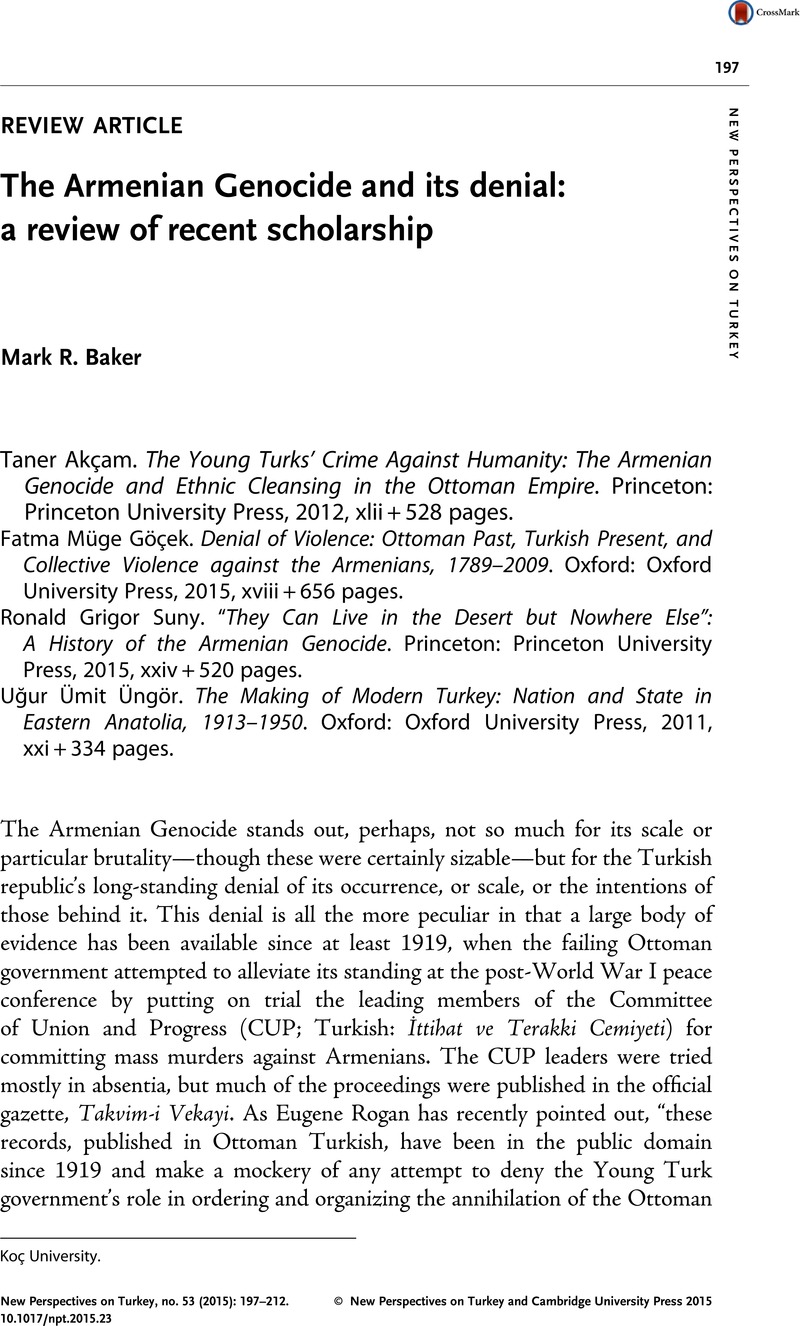Article contents
The Armenian Genocide and its denial: a review of recent scholarship
Review products
Published online by Cambridge University Press: 30 December 2015
Abstract

Information
- Type
- Review Article
- Information
- Copyright
- © New Perspectives on Turkey and Cambridge University Press 2015
References
1 Rogan, Eugene, The Fall of the Ottomans: The Great War in Middle East (New York: Basic Books, 2015), 389Google Scholar.
2 Akçam, Taner, Türk Ulusal Kimliği ve Ermeni Sorunu (İstanbul: İletişim Yayınları, 1992)Google Scholar.
3 In a 2009 raid on the ultranationalist, so-called “deep state” Ergenekon organization, Turkish authorities found a list of “traitors to national security.” The list had five names, including Hrant Dink, Orhan Pamuk, and Taner Akçam. See Akçam, Taner, The Young Turks’ Crime Against Humanity: The Armenian Genocide and Ethnic Cleansing in the Ottoman Empire (Princeton: Princeton University Press, 2012), xi–xiiGoogle Scholar.
4 Akçam, Taner, A Shameful Act: The Armenian Genocide and the Question of Turkish Responsibility, trans. Paul Bessemer (New York: Metropolitan Books, 2006)Google Scholar.
5 Akçam, , The Young Turks’ Crime, 128Google Scholar.
6 Suny cites Kévorkian, Raymond, The Armenian Genocide: A Complete History (London: I.B. Tauris, 2011)Google Scholar more than 100 times; Gust, Wolfgang, ed., The Armenian Genocide: Evidence from the German Foreign Office Archives, 1915–1916 (New York: Berghahn, 2014)Google Scholar 44 times; Akçam’s The Young Turks’ Crime 42 times, and Akçam’s A Shameful Act four times. Suny also cites and quotes from a great variety of documents from Ottoman, Armenian, German, Russian, and American archives.
7 Suny, Ronald Grigor, “They Can Live in the Desert but Nowhere Else”: A History of the Armenian Genocide (Princeton: Princeton University Press, 2015), 33CrossRefGoogle Scholar. The quotation in the book’s title is taken from United States Ambassador Henry Morgenthau’s memoir, in which he quotes CUP leader and Minister of the Interior Talat Pasha as stating to him in a private but heated conversation in early August 1915, “I have asked you to come here so as to let you know that our Armenian policy is absolutely fixed and that nothing can change it. We will not have the Armenians anywhere in Anatolia. They can live in the desert but nowhere else.” Morgenthau, Henry, Ambassador Morgenthau’s Story (New York: Doubleday, Page and Co., 1919), 338Google Scholar. Suny quotes from the 2003 edition, published by Wayne State University Press, 232.
8 Suny, , “They Can Live in the Desert”, 358Google Scholar.
9 Ibid., 359.
10 Ibid., 206.
11 Ibid., 359.
12 Ibid., 350.
13 Ibid. The distinction emanates from an effort to place culture at the center, rather than the broader definition of genocide, which might include politically or socially defined groups, such as Kulaks.
14 Ibid., 351.
15 Göçek, Fatma Müge, Denial of Violence: Ottoman Past, Turkish Present, and Collective Violence against the Armenians, 1789–2009 (Oxford: Oxford University Press, 2015), 4Google Scholar.
16 Ibid.
17 Ibid., 57.
18 For examples, see ibid., 116–117, 243, 344–345, 428.
19 Ibid., 173.
20 Göçek, Denial of Violence, 180.
21 The source cited is Kuran, Ahmed Bedevi, Harbiye Mektebinde Hürriyet Mücadelesi (İstanbul: Çeltüt, 1976), 118–119Google Scholar, 159, 163.
22 Çerkezyan, Sarkis, Dünya Hepimize Yeter (İstanbul, 2012)Google Scholar. Incidentally, Göçek gives an incorrect title for Çerkezyan’s memoir; see Göçek, Denial of Violence, 485.
23 Göçek, , Denial of Violence, 324–325Google Scholar.
24 Ibid., 150.
25 Ibid., 147.
26 Ibid., 383.
27 Ibid.
28 Ibid., 384, 504–549. The most famous and longest-serving of these was the later president Mustafa İsmet İnönü (1884–1973), who served in all of the first fourteen terms. Ibid., 516. Several former CUP members were reelected through the assembly’s eighth term, which ended in May 1950.
29 Ibid., 299–301.
30 Ibid., 151 and again on 155.
31 Ibid., 199. Göçek may be referring to the general mobilization order of the Ottoman Army on August 2, 1914, but this order did not mean that the empire was then joining the war. Indeed, as Erickson has pointed out, on August 9, 1914, Enver Pasha actually proposed an Ottoman-Russian alliance. More generally, at this time, “the Ottoman leadership, as a whole, was not absolutely committed to war;” rather, “the Turks were attempting to retain as many options available as possible.” Erickson, Edward J., Ordered to Die: A History of the Ottoman Army in the First World War (Westport, CT: Greenwood Press, 2001), 31Google Scholar. Rogan concurs: “Yet the Ottomans, who had been so impatient to conclude a defensive alliance, were in no hurry to enter a world war.” Rogan, , The Fall of the Ottomans, 41Google Scholar.
32 Göçek, , Denial of Violence, 385Google Scholar, 390.
33 Üngör, Uğur Ümit, The Making of Modern Turkey: Nation and State in Eastern Anatolia, 1913–1950 (Oxford: Oxford University Press, 2011), viiCrossRefGoogle Scholar.
34 Zürcher, Erik-Jan, “The Ottoman Legacy of the Turkish Republic: An Attempt at a New Periodization,” Die Welt des Islams 32 (1992): 237–253Google Scholar.
35 Üngör, , The Making of Modern Turkey, 17Google Scholar.
36 Ibid., 106.
37 Ibid., 121.
38 Ibid., 167.
39 Ibid., 168–169.
40 Ibid., 262.
41 Ibid., 248.
42 https://www.ictj.org/sites/default/files/ICTJ-Turkey-Armenian-Reconciliation-2002-English.pdf. Also see de Waal, Thomas, Great Catastrophe: Armenians and Turks in the Shadow of Genocide (Oxford: Oxford University Press, 2015), 212–213Google Scholar, 257.
43 Göçek, , Denial of Violence, 413Google Scholar.
44 Important in this regard was Prime Minister Recep Tayyip Erdoğan’s April 24, 2014 message, which, while implying that Armenian and Muslim suffering were equivalent, concluded with the words, “we wish that the Armenians who lost their lives in the context of the early twentieth century rest in peace, and we convey our condolences to their grandchildren.” http://www.mfa.gov.tr/turkish-prime-minister-mr_-recep-tayyip-erdogan-published-a-message-on-the-events-of-1915.en.mfa.
45 See, for example, the interview by CivilNet’s Alin Ozinian with Selahattin Demirtaş, the co-chair of HDP, “Demirtaş: Turkey Must Face the Armenian Genocide,” December 23, 2014, http://civilnet.am/2014/12/23/selahattin-demirtas-kurds-armenian-genocide-1915-democracy-turkey-english/#.Vcm9QPmqqkp.
- 2
- Cited by

